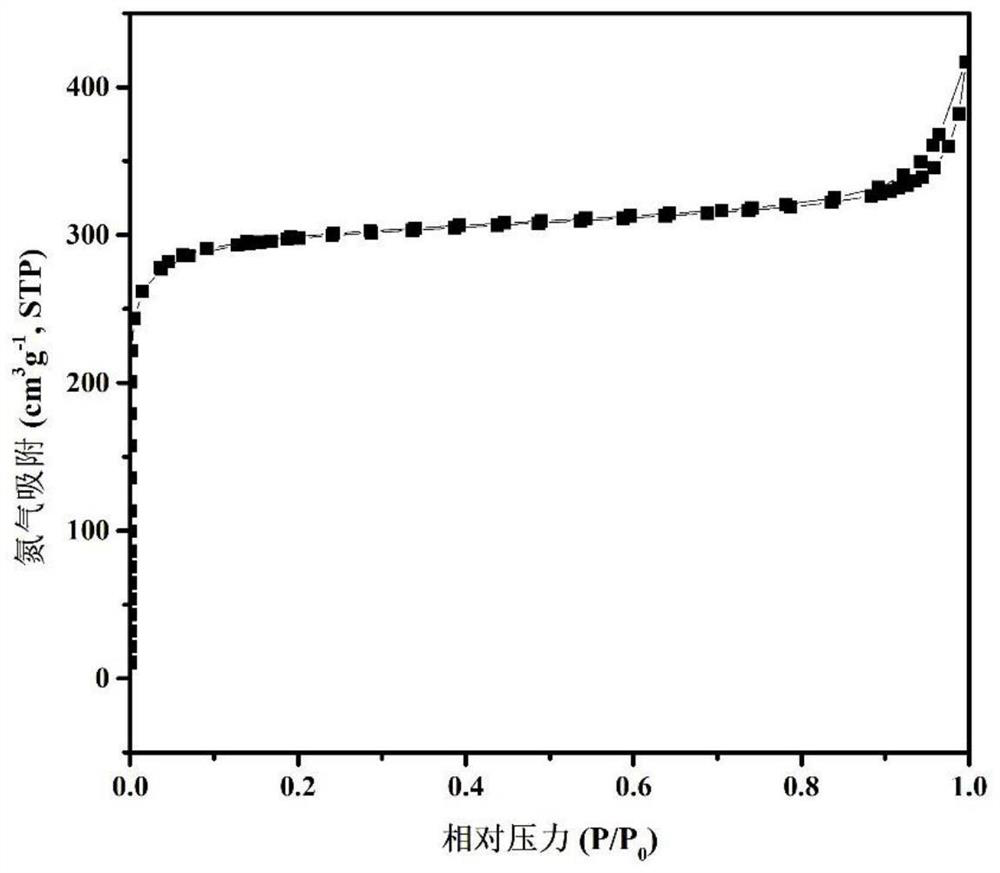Method for degrading organic pollutants in water by activating peracetic acid with nitrogen-doped carbon material
An organic pollutant, nitrogen-doped carbon technology, applied in the field of water treatment, can solve the problems of low efficiency of carbon nanotubes, difficult to separate, secondary pollution, etc., and achieve the effects of low cost, reduced treatment cost, and easy operation.
- Summary
- Abstract
- Description
- Claims
- Application Information
AI Technical Summary
Problems solved by technology
Method used
Image
Examples
preparation example Construction
[0036] In the present invention, the preparation method of the carbonized polyaniline preferably comprises the following steps:
[0037] mixing aniline, hydrochloric acid aqueous solution and ammonium persulfate aqueous solution to carry out polymerization reaction to obtain polyaniline;
[0038] Under a protective atmosphere, the polyaniline is carbonized and then cooled to obtain carbonized polyaniline.
[0039] In the present invention, it is preferred to mix aniline, hydrochloric acid aqueous solution and ammonium persulfate aqueous solution to carry out polymerization reaction to obtain polyaniline. In the present invention, the purity of the aniline is preferably ≥99.5%, and the aniline is preferably commercially available analytically pure aniline (with a concentration of 0.018 mol / L). In the present invention, the molar concentration of the hydrochloric acid aqueous solution is preferably 90-540 mmol / L, more preferably 150-450 mmol / L, and even more preferably 200-300 ...
Embodiment 1
[0072] According to the molar ratio of aniline and hydrochloric acid 1:2, 1.6mL of aniline (0.018mol, analytically pure, purity ≥ 99.5%) was dissolved in 100mL of 360mM hydrochloric acid aqueous solution and stirred for 0.5h as a monomer solution, and the obtained monomer solution was placed at 0°C In the following ice bath, add 100mL ammonium persulfate aqueous solution (180mM) according to the molar ratio of ammonium persulfate and aniline 1:1, and carry out the polymerization reaction for 4h; Wash the filter cake alternately with ultrapure water until the filtered solution is colorless; collect the solid and dry it in a vacuum oven at 60°C for 24 hours to obtain polyaniline;
[0073] The polyaniline was placed in a tube furnace, heated to 900°C at a rate of 5°C / min under a nitrogen atmosphere, carbonized for 4 hours, cooled to room temperature at a rate of 1°C / min, and ground to a particle size 350nm, to obtain carbonized polyaniline, denoted as CPANI-9, the prepared CPANI-...
Embodiment 2
[0076] Put 200 mg of graphene oxide GO in a beaker containing 100 mL of ultrapure water, ultrasonically disperse for 2 h to obtain a GO aqueous solution, add 1 g of urea to the GO solution and stir for 0.5 h, transfer the obtained beaker containing the mixed solution to a vacuum freezer In the dryer, freeze-dry for 24 hours to obtain the precursor;
[0077] The precursor was placed in a tube furnace, heated to 600 °C at a rate of 5 °C / min under a nitrogen atmosphere, carbonized for 4 h, cooled to room temperature at a rate of 1 °C / min, the sample was taken out and ground and Collect after sieving (200 mesh) to obtain nitrogen-doped graphene, denoted as NG, the nitrogen doping amount of prepared NG is 11.39%, and the particle diameter is 400nm;
[0078] The phenol aqueous solution of 1mg / L is joined in the 100mL beaker, stir under the condition of 500rpm, add peracetic acid solution (mass fraction is 15%), adjust pH value to 7 with NaOH solution (mass concentration is 20g / L), o...
PUM
| Property | Measurement | Unit |
|---|---|---|
| Particle size | aaaaa | aaaaa |
| Length | aaaaa | aaaaa |
| Specific surface area | aaaaa | aaaaa |
Abstract
Description
Claims
Application Information
 Login to View More
Login to View More - R&D Engineer
- R&D Manager
- IP Professional
- Industry Leading Data Capabilities
- Powerful AI technology
- Patent DNA Extraction
Browse by: Latest US Patents, China's latest patents, Technical Efficacy Thesaurus, Application Domain, Technology Topic, Popular Technical Reports.
© 2024 PatSnap. All rights reserved.Legal|Privacy policy|Modern Slavery Act Transparency Statement|Sitemap|About US| Contact US: help@patsnap.com










